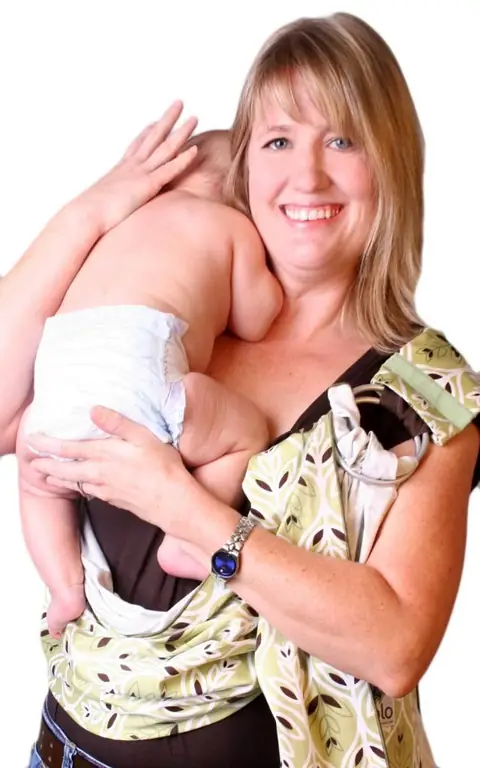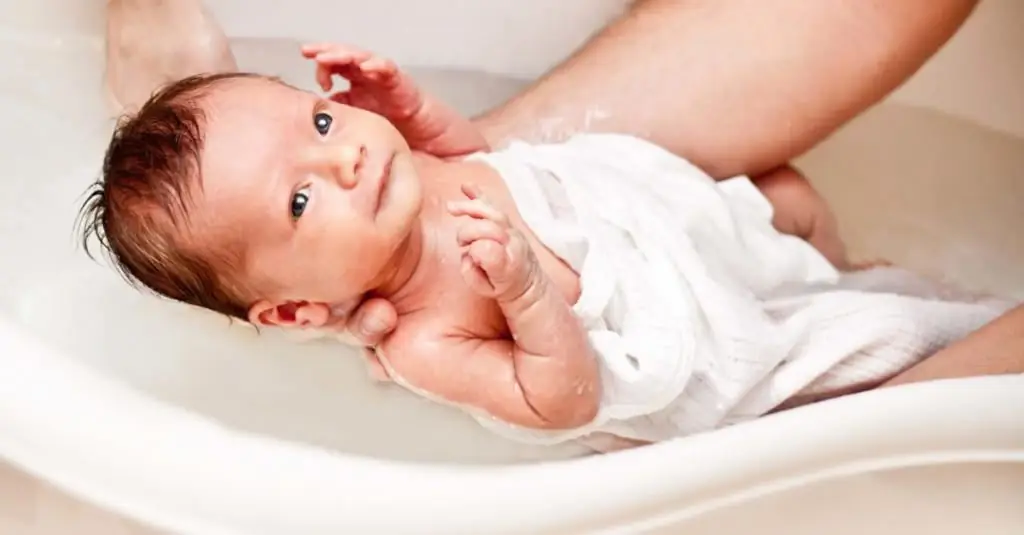2026 Author: Priscilla Miln | [email protected]. Last modified: 2025-01-22 17:55:26
The first few weeks after the birth of a newborn baby is a difficult time for all parents. Especially if the firstborn was born. Newly minted moms and dads are worried about a lot of questions regarding the rules of care and hygiene of the crumbs.
One of the final stages of delivery is cutting the umbilical cord, which connects the baby's bloodstream to the mother's placenta. As a result of simple manipulation, a small section of the umbilical cord remains, the size of which, as a rule, does not exceed two centimeters. It is very important to carefully care for this part of the baby's body, following the necessary rules. In the maternity hospital, the medical staff conducts manipulations to care for the baby's umbilical wound.
A new mom needs to be closely monitored by a doctor or nurse. In a few days, these procedures will become her responsibility. However, not every mother knows what actions will contribute to the speedy healing of the umbilical wound and what precautions should be taken so as not to harm the baby.
How a newborn's navel heals
Fullhealing of the umbilical wound occurs within three to four weeks. In some cases, the process may take longer. The healing of an umbilical wound can be divided into several stages. Immediately after cutting the umbilical cord, a special clothespin is placed on the affected area. It disappears after three or four days. During this time, the remaining small section of the umbilical cord should finally dry out and fall off.
In the first three weeks of a newborn's life, the navel will heal like a normal deep wound. It may bleed from time to time. There shouldn't be much blood. Otherwise, you should immediately consult a doctor.
Preparing for the procedure

First you need to prepare all the necessary tools for processing. This is:
- dropper;
- cotton pad or stick;
- tweezers;
- chlorhexidine solution;
- hydrogen peroxide;
- brilliant green or potassium permanganate.

"Chlorhexidine" is an excellent remedy with antiseptic properties. The advantage is the absence of any smell and color. "Chlorhexidine" is completely safe to use. With the help of hydrogen peroxide, you can get rid of the ichor. Zelenka and potassium permanganate solution reliably protect the umbilical wound of a newborn baby from the effects of infections and pathogenic bacteria. Doctors recommend buying a ready-made potassium permanganate solution, and not making it yourself. The slightest imbalance cancause burns.
It is very important to thoroughly wash and then dry your hands before starting treatment of the umbilical wound, treat them with an antiseptic solution.
How to treat an umbilical wound

Wound treatment should be carried out twice a day: during morning hygiene procedures and in the evening before going to bed after bathing. The baby should not be wearing clothes. A changing table or a special board is ideal for processing. First you need to put a clean diaper under the baby's body, only after that you can start processing the navel.
Processing order

It is very important to follow the algorithm below when caring for the umbilical wound of a newborn:
- The umbilical wound needs to be slightly stretched with the index and thumb of one hand.
- After that, you need to put a few drops of hydrogen peroxide on the baby's navel and leave for one minute. Foam will appear on the surface of the wound. This is considered normal and indicates that particles of blood are present in the umbilical wound.
- Then you need to remove the caked blood with a sterile cotton swab. This will prevent the entry of germs.
- With a cotton swab or cotton swab, you need to slightly dry the umbilical wound. Then, with another stick, it is necessary to treat the baby's wound with a solution of chlorhexidine.
- At the end, you need to lubricate the wound with brilliant green or a solution of potassium permanganatesterile cotton swab or swab.
It is not recommended to apply the product around the navel. This is fraught with the formation of a burn. In some cases, a crust may form. There is no need to remove it, after a while it will disappear on its own.
End of procedure

After completing the procedure, wash your hands thoroughly with soap and treat them with an antiseptic solution. After that, you can start dressing the baby. It must be remembered that clothes for a newborn baby should be comfortable. It's best to buy clothes made exclusively from natural materials.
You need to put on a diaper very carefully so that it does not touch the umbilical wound. There are even diapers with a navel cutout. If parents have opted for reusable diapers, it is very important to change them in a timely manner, preventing urine and feces from entering the umbilical wound. If the parents are swaddling enthusiasts, don't pull the diaper too tight.
All clothes and diapers must be carefully ironed. For washing children's clothes, it is better to use special hypoallergenic powders without fragrances. This will help prevent allergic reactions.
Can I bathe my baby until the umbilical wound is completely healed?

This question worries many parents. The opinions of experts on this matter differ. Some experts argue that it is worth refraining from swimming until completehealing of the umbilical wound, others are sure of the need for water procedures. According to the second, the wound may not heal for a long time, and the lack of proper cleansing of the skin will not lead to anything good. The newborn may develop irritation and prickly heat. That is why many pediatricians recommend starting bathing a baby as early as the second day after discharge from the hospital.
How to bathe a newborn baby

So that water procedures do not harm the newborn baby, moms and dads should know how to do it right. First of all, it should be noted that you need to bathe the baby every day. After the child reaches six months of age, the frequency of procedures can be halved.
You need to bathe a newborn in a separate bath, which should be thoroughly washed before use. If the doctor has allowed bathing, and the wound has not yet healed, it is recommended to add a few drops of calcium permanganate to the water.
The water should turn slightly pink. When the umbilical wound heals, there will be no need to add potassium permanganate to the water. You can replace the solution with a decoction of various herbs with antiseptic properties.
Some pediatricians strongly recommend pre-boiling the water in which water procedures will be carried out. You can start swimming only if the water temperature has reached 36 degrees. This indicator is optimal.
The air temperature in the room should be at least 22degrees. Experienced experts strongly recommend bathing the baby in the evening before bedtime. Do not resort to the use of shampoos, gels and bath foam. It is necessary to refrain from using such hygiene products at least in the first six months of a newborn baby's life. To wash the body and hair, you can use the most ordinary baby soap. Soap can be used no more than once a week, otherwise you can dry out the skin of the child.
Bathing should not last longer than 10 minutes. It is not recommended to cover the wound with synthetic materials, as they have poor breathability. After bathing, you can start caring for the umbilical wound of a newborn at home.
What is an umbilical hernia and is it dangerous?
The healing process of the umbilical wound in some cases may be overshadowed by the appearance of an umbilical hernia. The cause is mainly an increase in intra-abdominal pressure.
Diagnosis of a hernia can be done not only by a specialist, but also by parents at home. If you have the slightest suspicion, you should immediately consult a doctor. The doctor sets the hernia inward and connects the skin around the navel into a fold, after which it fixes it with a band-aid. In some cases, such manipulations may not be necessary. As a rule, the specialist recommends wearing a special bandage. To speed up the healing process, parents can massage the umbilical ring two to three times a day.
Conclusion
The birth of a baby is an important event. Newly minted parents are concerned not only with feeding and hygiene, but alsomany other questions. One of the most important concerns the rules for caring for the umbilical wound of a newborn at home.
It is very important to comply with all conditions and nuances. As a rule, care for the umbilical wound of a newborn with a clothespin is provided by medical personnel in the maternity hospital. This device disappears 2-3 days after the birth of the baby, along with the remnants of the umbilical cord. That is why parents need to know the rules for caring for the umbilical wound of a newborn without a clothespin.
Recommended:
Caring for a newborn baby in the first month of life: basic rules

Often, the expectation of a baby becomes a joyful event for all family members. A mother who already has children behaves more balanced and calm during pregnancy than a woman who is pregnant for the first time. Usually this condition is associated with a lack of experience and fear of not being able to cope with a tiny creature. We will help young mothers gain confidence and talk about caring for a newborn baby in the first month of life
Caring for a newborn baby: features, recommendations

Caring for a newborn baby. What rules must be followed. Features of care. Is swaddling necessary? How to regulate feeding. What do you need to prepare at home for discharge from the hospital? Hygiene rules. When to bathe a newborn and go for a walk for the first time?
How long does a chinchilla live at home and what are the basic rules for caring for it?

Who is a chinchilla? How to take care of her? How long does a chinchilla live at home? What “don’ts” are important to consider in order to maximize her life expectancy?
How to hold a baby: rules for caring for a baby, necessary knowledge and skills, tips

The birth of a child is a very touching and crucial moment. If this is the first child for newly-made parents, then even in the maternity hospital they will have many questions related to caring for the newborn. The vast majority of parents admit that they do not know how to hold the child in their arms until the baby gets stronger, that is, in the first 2-3 months. But by learning a few simple rules and recommendations for caring for a newborn, you can enjoy positive moments without fear
Do I need to boil water for bathing a newborn: rules for bathing a newborn at home, water sterilization, adding decoctions, folk recipes and recommendations from pediatricians

Bathing a small child is not only one of the ways to keep the body clean, but also one of the ways to stimulate breathing, blood circulation in the body. Many parents ask themselves questions: is it necessary to boil water for bathing a newborn, how to choose the right temperature and where to start the water procedure

